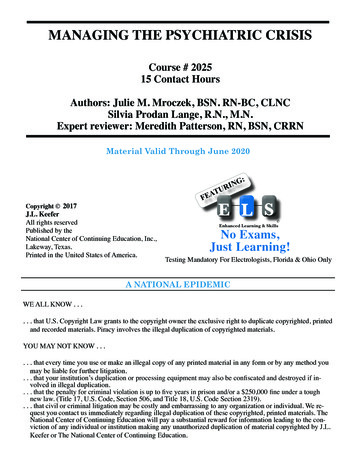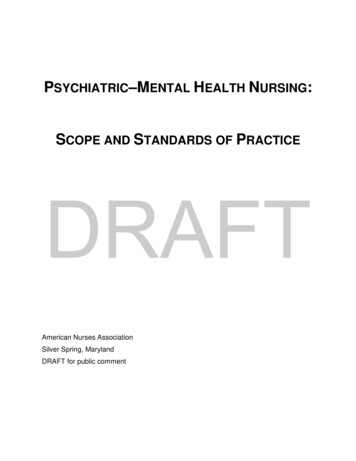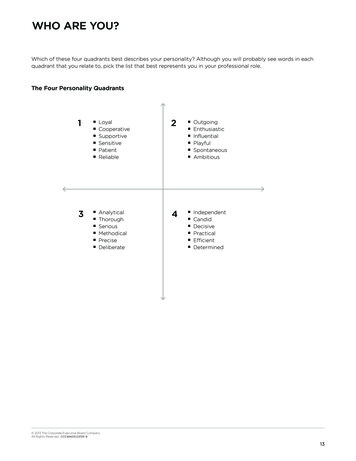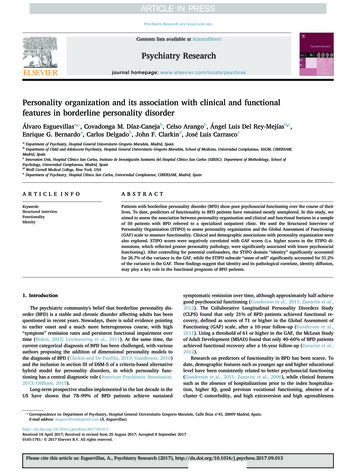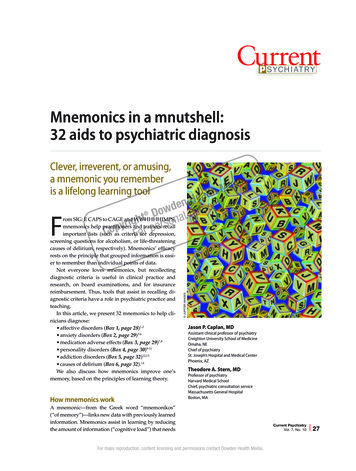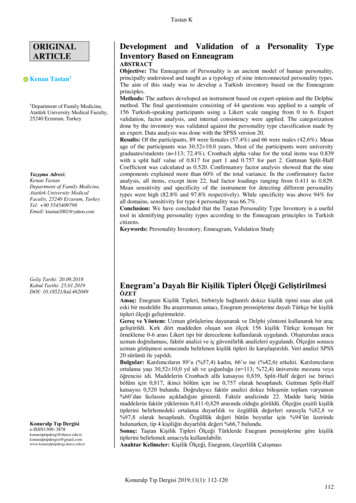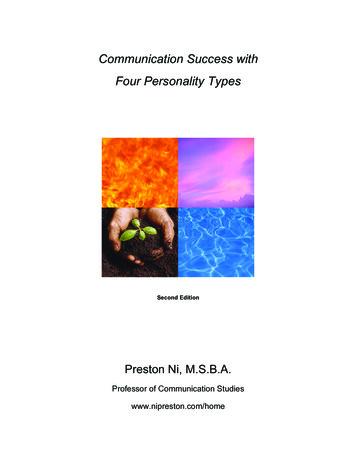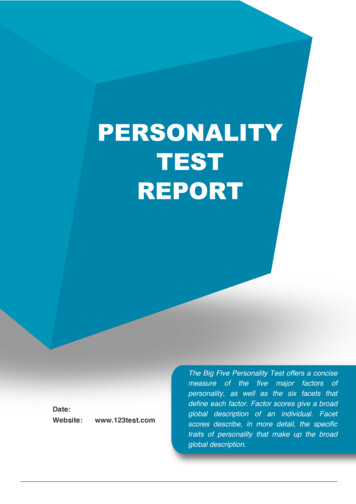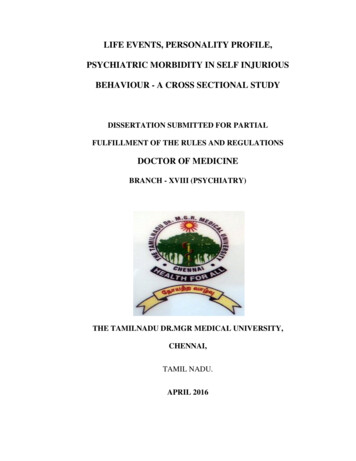
Transcription
LIFE EVENTS, PERSONALITY PROFILE,PSYCHIATRIC MORBIDITY IN SELF INJURIOUSBEHAVIOUR - A CROSS SECTIONAL STUDYDISSERTATION SUBMITTED FOR PARTIALFULFILLMENT OF THE RULES AND REGULATIONSDOCTOR OF MEDICINEBRANCH - XVIII (PSYCHIATRY)THE TAMILNADU DR.MGR MEDICAL UNIVERSITY,CHENNAI,TAMIL NADU.APRIL 2016
CERTIFICATEThis is to certify that the dissertation titled “LIFE EVENTS,PERSONALITY PROFILE, PSYCHIATRIC MORBIDITY INSELFINJURIOUSBEHAVIOUR-ACROSSSECTIONALSTUDY” is the bonafide work of Dr.K. ILAMARAN, in part fulfillmentof the requirements for M.D (Psychiatry) (Branch–XVIII) examination ofThe Tamilnadu Dr. M. G. R Medical University, to be held in APRIL2016. The Period of study was from March 2015 to August 2015.HODKilpauk Medical College &Hospital, Chennai - 10DEANKilpauk Medical College &Hospital, Chennai – 10.
DECLARATIONI, Dr. K. ILAMARAN, solemnly declare that dissertation titled“LIFE EVENTS, PERSONALITY PROFILE, PSYCHIATRICMORBIDITY IN SELF INJURIOUS BEHAVIOUR - A CROSSSECTIONAL STUDY” is a bonafide work done by me at Kilpaukmedical college, Chennai, during the period from March 2015 to August2015, under the guidance and supervision of Dr. S. RAJARATHINAMM.D., DPM., HOD, Professor of Psychiatry, Kilpauk Medical College.This dissertation is submitted to The Tamilnadu Dr. M. G. R MedicalUniversity, towards part fulfillment for M. D. Branch – XVIII(Psychiatry), part- III examination.Place:Date:ChennaiDr. K. ILAMARAN
ACKNOWLEDGEMENTI sincerely thank Prof. Dr. R. NARAYANA BABU, MD., DEAN,Kilpauk Medical College for permitting me to do this study.I sincerely thank Prof. Dr. S. RAJARATHINAM . M.D., DPM.,Head of the Department, Kilpauk Medical College for his, concern, care,guidance and help, and I would like to thank to Dr. R. SARAVANAJOTHI, MD., who has been a source of inspiration and motivation.I would like to express my sincere thanks to Assistant Professor,Dr. M. S. JAGADEESAN, who has guided me in completing thisdissertation. I thank my colleagues, and others for their immense help incompleting this study. I would be failing if I do not express my gratitudeto all my Teachers at the Department of Psychiatry, Kilpauk MedicalCollege, Chennai for their support and encouragement during this study.I thank all those patients who participated in the study, withoutwhom this study would have been only a dream.
LIST OF ABBREVIATIONWHO-World Health OrganizationSIB-Self Injurious BehaviourSA-Suicide AttemptDSH-Deliberate self harmLAS-Lethality assessment scalePSLE-Presumptive stressful life eventsEPQ90-Eysenck Personality Questionnaire 90GHQ12-General Health Questionnaire 12SCL90-Symptom Check list 90
CONTENTSSl.No.Page No1.Introduction12.Review of Literature103.Aim and Objectives264.Materials and Methods285.Results366.Discussion617.Summary and dices
INTRODUCTIONAccording to World Health Organization (WHO), Suicide is thesecond leading cause of death between 15 and 29 years of age groups,globally (2012). It’s responsible for 1. 4% of all deaths world wide. WHOdefines suicide act as ‘the injury with varying degrees of lethal intent,”and that suicide may be defined as a suicidal act with fatal outcome. Theword suicide' has its origin in Latin; sui', of oneself and credere', to kill:the act of intentionally destroying one's own life. In 2012, Indiaaccounted for the highest suicidal rate. According to WHO report, oneperson commits suicide every 40 seconds globally. In the world, mostsuicides occur in the South-East Asia region.SuicideThe term suicide is used to denote self-planned and deliberatetermination of one’s life. It is as old as mankind and is indeed a giantpuzzle. It is a paradox why humans who love to live a full life turn to selfdestruction.Para suicide :It is an impulsive act of self – injurious behavior without any priorplanning or intent to die. The harm to self may be done by inflictinginjury or consuming a substance. It is otherwise known as DeliberateSelf-Harm (DSH) ,( Kreitman (1977).1
Attempted suicide:Among those who attempt suicide, a few succeed, but somesurvive due to timely intervention of chance factors in spite of bestplanning and clear cut intention to die. They are known as ‘AttemptedSuicide’.Overlap :A person who tries to terminate his life with real intent maysurvive. However, an individual who injures himself impulsively withoutany real intent to die may lose his life.Another meaning for suicide in latin word, is self murder. Thereare some types of suicides. The general term used for suicide attempt isself injurious behavior (SIB) which is further subdivided into suicidalattempt (SA) and nonsuicidal self injury (NSSI).( Chloe A. Hamza ,Shannon L. Stewart Teena Willoughby,2012 ). Usually the SA are withintent and NSSI are without intent to die. Non suicidal self injury(NSSI),which is defined as self-directed, deliberate destruction or alteration ofbodily tissue in the absence of suicidal intent (Nock & Favazza, 2009),examples are self-cutting, head banging, self-hitting, scratching to thepoint of bleeding, and interfering with wound healing. Suicidal behaviorsrefer to directly self-injurious behaviors (e. g., suicide attempt, suicide)that are engaged in, with an intent to end one's life such as hanging,2
severe slashing, and jumping from heights. NSSI and suicidal behaviorsare both forms of self injurious behavior, and therefore they aresometimes conceptualized as falling along a single self-harm continuum(Chloe A.et al 2012 )The suicidal behaviors range from suicidal ideas to completedsuicide. It depends on the various factors like age, gender, socioeconomicstatus, occupational status, educational status, and marital status.Statistics on suicidal behavior varies between different nations. Indeveloped countries about 10% of the suicides were underestimated,whereas in developing countries most of the suicides were underreported.The overall mortality from suicide was underestimated according toCharlton et al, (1992). Among the suicide attempters, about half of thethem had previous suicide attempts. Most of the suicide attempters hadprevious deliberate self harm (DSH) injuries like slashing the hands, legsand body. In the Indian context most of the individuals with a history ofDSH, are more likely to indulge in further suicidal behavior by drugoverdosages, organophosphorous poisoning , rat killer poisoning, phenolliquid poisoning and oleander seed poisoning apart fromhanging.Among the suicide attempters, male suicide attempters were found to bemake more violent attempts, with high suicidal intention and lethality.Most of the male suicide attempts were due to subjective lack ofsuccess or failures in their achievement while in the female, suicide3
attempts were due to negative interpersonal events. There are risk andprotective factors for suicide which include cultural, social, psychologicaland biological factors. The suicide attempts were due to intensifiedeffects of risk factors or weakened effects of protective factors. The othercommonly occurring risk factors are elder by age, low socioeconomicstatus, low educational status, unmarried people, divorced, widowed,living alone, unemployment, retirement, students, prisoners, immigrants,refugees, low social support and lack of social integration.Suicide rate has been raising in younger males for the past 20years because of the alcohol misuse, problem in the school and variouspsychosocial stressors. Learning model is also a risk factor for suicide,which is available in the society, culture, institution and mass media. Therelationship in the society has a significant impact in the individual, whenthere is a disturbance in the relation between the individual and thesociety, the suicidal tendency might occur.Life event stressors prior to suicide attempts had a significant role.The number of stressors were also important in determining the suicide.Usually a combination of life event stressors would occur rather than asingle life event stressor. Persons with self injurious behavior would havelower level of physical well being, psychological well being, socialrelations. Dissatisfaction with life was a risk factor for suicide.(Koivumaa-Honkanen, H. 2001)4
STRESS:Stress is a well known cause for mood disorder, mentaldisorder and risk factor for suicide attempt. Negative life events lead todepression, interpersonal problem, occupational problem and selfinjurious behavior. Childhood trauma has a significant impact in suicidebehavior. Also unemployment, loss of job, financial problem contributedtowards suicide. The stressors are recent one, which might be weeks tomonths prior to suicide attempt.There was an increased suicidal behavior present in young femalesand in low socioeconomic status. (King, Raskin, Gdowski, Butkus, &Opipari 1990). Chronic physical illness also had a tendency to increasethe suicidal behavior. Stressful life events and social problem happenedin the recent time may lead to suicide (Townsend et al 2001).There is a terminology known as ‘kindling effect’ otherwise calledEpisode sensitization , in which individuals with repeated episodes ofselfharm, bring about neurobiological, cognitive and interpersonalchanges that directly increase the risk of recurrence. In multiple episode,there is a weak association between stressful life events and suicidalideation than person with single attempt of suicide. One of the risk factorin suicide attempt is job loss and unemployment. (Beautrais et at 1997).Another study says that major interpersonal problem is a risk factor for5
suicide in adults associated with substance abuse. Some of the individualwith life events stressors would attempt suicide within a day of a stressor(Kenneth R. Conner, 2011). Some other psychosocial stressors also had arole in suicide, like interpersonal losses, legal issues or disciplinarians,pregnancy or fear of pregnancy, loss of freedom, loss of self esteem,physical and sexual abuse.PERSONALITY:Most suicide attempts were done by persons with abnormalpersonality(Hanet,al;1997,).The risk factors are aggression, greaterimpulsivity, substance abuse, antisocial personality disorder, depression,Bipolar affective disorder I & II and with previous suicide attempt,genetic factor and life event stressors. Sometimes there is an overlapbetween borderline personality disorder and Bipolar affective disorders.Most of the suicidal attempters had childhood physical abuse or sexualabuse. The commonly encountered personality disorder in suicides areborderline personality disorder, Narcissistic personality disorder andHistrionic personality disorder.Suicide in Schizotypal personality is understudied. Schizoidpersonality disorder is associated with depression, anxiety andPosttraumatic stresss disorder. According to Psychc info Data baserecord(c),( 2010), Schizoid personality is associated with violent6
behavior. According to previous study results 70% of the borderlinepersonality disorder had atleast one suicide attempt in their lifetime.Borderline personality disorder is also called Emotionally unstablepersonality disorder which is further divided into impulsive type andborderline type, coming under cluster’ B’ personality. Impulsivity is oneof the feature of borderline personality and is frequently associated withalcohol or any other substance abuse, eating disorder, unprotected sex,reckless spending, reckless driving, frequent job changes, running awayand self injury and other features are unstable interpersonal relations,anger outburst, idealization, devaluation, minimization, maximization,sensitivity to the feeling of rejection, criticism and isolation. There werean association between substance abuse on recurrent suicide attemptswas found in a study of Berk etal.(2007), but this finding was notconfirmed in Soloff and Chiappetta (2012).In borderline personality disorder, the time prevalence of suicideattempt is 3-10%. Men completing suicide in this disorder has beenunderestimated being almost twice as women. The reasons for NSSI areexpressing anger, self punishment, distracting oneself from emotionalpain. NSSI is one of the feature of the borderline personality disorder.This should be actively intervened because there is a possibility of seriousself injury. The further risk of suicide increases after more attempts and7
more unsuccessful treatments (Zahl and Hawton,2004; Paris,2007; Soloffand Chiappetta,2012).Many of the DSH would lead not only to recurrent DSH but alsoto a serious suicide attempt. Personality disorders predispose to majormental illness like depression, and substance abuse. Among the antisocialpersonality disorder 5% commit suicide. Horrocks . J et al (2003) studyshowed that emotionally unstable personality and impulsive typepersonality trait or disorder was the commonest personality disorder inself injurious behavior. Personality disorder itself increases the selfinjurious behavior. Life events stressors in personality disorders increasesthe suicidal ideations. Suicidal proneness, psychological distress havebeen noted in schizoid personality, schizotypal personality, borderlinepersonality, depressive personality and sadistic personality.Childhood adversity and comorbid mental illness increase thesuicidal rate. Based on the previous studies, that the presence of anxietyand depressive disorder increases the risk of suicide attempts andcompleted suicide (Angst et al., 1999; Sareen et al., 2005; Ten Have etal., 2009). Heritability contributes 40% in borderline personality disorder.Some of the studies found that there are some reduction of the areas in thebrain like hippocampus, orbitofrontal cortex and amygdala. Familyhistory of suicide attempts, sexual abuse, high level of impulsivity,8
antisocial traits are risk factors for this personality disorder. (Black,Blum, Pfohl Hale 2004, Oldham 2006.)PSYCHIATRIC ILLNESS:There are psychiatric illness like depression, anxiety, adjustmentdisorder, substance use disorder, schizophrenia and bipolar disorders inwhich suicide attempt can occur. Among the psychiatric illnesses thedepression is the commonest disorder. According to previous studyresults, when there is a combined occurrence of depression and anxietythe suicidal rate is more common than the depression alone. Anxiousmood may lead to negative thinking, which may be a predisposing factorfor suicide. In India the common psychiatric disorders leading to suicideattempts are adjustment disorder, depression, substance abuse.The rate of suicidal attempts are low in India when compared toWestern countries. In Western countries 90% of the suicides were due topsychiatric illness. According to previous study results 60%-70 % of thepatients with depression would attempt for suicide, 15%-20% of theBipolar affective disorder would attempt for suicide and other mooddisorder would contribute to about 10%-15% of suicide, and patients withschizophrenia would contribute to 10% of the suicide.9
REVIEW OF LITERATUREThe term attempted suicide gives a wide meaning from severe andlife threatening attempt to minor gestures. Complete suicide is relativelyuncommon. The suicide should be viewed as a symptom rather than adisease per se.PARASUICIDE:Deliberate self poisoning and self injury term was proposed by(Kessel, (1965). In the 1970s, Kreitman (1977), who introduced the termparasuicide, in which the individual would have self mutilating behaviorlike cutting the skin, but they do not wish to die, the female – male ratiowas 3:1, they will be 4% of the all psychiatric patients, among them 30%might be having substance abuse.The parasuicide attempter’s age will be around 20 years and theywill be single or unmarried. The nature of the cut will be delicately, notcoarsely by using razor blade, knife and broken glass. The common siteswere wrist, arms, thighs and legs and the uncommon sites were face,breast and abdomen. Most of these individuals would be suffering froma personality disorder and also they will be neurotic and introverted.Weissman, (1974) study showed that 1-10% of the completedsuicide had previous suicide attempt.10
PSYCHOLOGICAL FACTORS:The first important psychological insight into suicide came fromSigmund Freud.Sigmund Freud, in mourning and melancholia, wrote of aggressionturned inward when one internalizes a lost object and then turns this rageon to oneself. Edwin Schneidman has written as victim’s unbearablemental pain “psychache” and how terminally his or her perceptionsnarrow and he or she can see only one solution-his or her death.Contemporary suicidologists stress that people most likely to commitsuicide are those who have suffered the loss of a love object or havesustained a narcissistic injury, who experience overwhelming moods likerage and guilt, or who identify with a suicide victim. According to Freud,“suicide is an aggression turned inwards against a loved person withwhom the individual has identified himself”Psychodynamics of suicides: It is a plea for help. It is a final exit from all bonds. It is a threshold of peace and permanent bliss. It is a sacrifice and self atonement. It an escape from pain & misery. It is a reunion with the beloved.11
It is a beginning of new life through rebirth. It is a mastery over death. It is revenge against his persecutors. It is an act to punish the enmities. It is an act of rescue.BIOLOGICAL FACTORS:There are some evidence of involvement of biogenic amines insuicides. According to Julius Axelrod’s study (1970) there is a relationbetween suicide and biogenic amine metabolism. Marie Asberg’s (1975)work on levels of serotonin and noradrenaline levels in the brains ofdepressive individuals laid the ground work for a later suicide. Otherneurotransmitters involved in suicides are GABA (gamma amino butricacid), G protein, glutamate receptors, kinases, BDNF. Some other studiessay that there was a decreased level of 5HT in depressed individuals withsuicide attempt.SOCIOLOGICAL FACTORS:Emile Durkheim, a French sociologist emphasized the importanceof social factors in the causation of suicide. According to him, the suiciderate of a population varies inversely with the degree of social integrationin that population.12
There are 3 types of suicide:1 . Egoistic2. Altruistic3. AnomicEgoistic suicide:Here the individual has little concern for the community (family,religion or community)E. g. unmarried, widowed, unemployed, deprived, and bereaved.Altruistic suicide:Here, the individual has excessive integration with to society. Thecustoms & rules of the society demand his death under certain condition.Here the individual gives his life as a priced gift to answer the demandsof the societyE . g. sati in India / harakiri of Japan / mass suicide in cultAnomic suicide:Here, the existing relationship between the individual and hissociety is shattered all on a suddenE . g. economic recession, loss of employment, wealth or statusIn addition to social integration, status integration is also important as aprotection against suicide (social role like father, teacher, married,employed, leader) . The more the status, better the social integration andbetter the immunity against self harm. Research shows that suicidal13
behaviour increases markedly during this time and the causes are moresocial and interpersonal conflicts (Shaffer and Fisher, 1981; Brooksbank,1985 & Hawton et al., 1982). Hopelessness has been identified as one ofthe core characteristics of depression by Beck (1963). The features ofhigh hopelessness group were anxious and depressed mood, had a strongwish to die, made a planned attempt, act was done for relief from mentalstate, motivated for help and sought help. Rifai et al.,(1994), study shownthat the individuals with suicidal attempts had high scores inhopelessness.BIO PSYCHO SOCIAL FACTORS:The cortico- hypothalamic pituitary adrenal axis, which regulatesadrenal cortical hormone levels and mediates reaction to stress. Theelevated corticotrophin releasing factor( CRF) concentration in CSF anddecreased number of CRF binding sites in the frontal cortices of suicideattempters were present. Another study shows the alcohol itself decreasesthe 5 HT in some areas of brain in depressed individuals. Alcohol is awell known disinhibitor that increases the impulsivity leading to suicideattempt.AGE:It has been found across various studies that the incidence ofattempted suicide was greatest in young adults (Morgan et al. 1976,14
Holding et al., 1977). The rate of Adolescent suicide attempts areincreasing in numbers (Hawton et al. 1982; Brooksbank, 1985). Amongthe adolescents, suicide attempt was estimated to be about 8%-10% intheir life time. The old age also prone for suicide when they are livingalone without family support, and also if they have associated comorbidphysical and psychiatric illness.GENDER:There is a wide disparity about incidence of suicide and gender .Some western countries shows higher incidence in males, and indeveloping countries more incidence was seen in females. The studies byGarfinkel B. D. et al., (1982), Otto (1972), L. Kotila et al., (1987) andOlfson et al (2005), showed that the higher incidence of suicide occurs inadolescent females. There is Male–female disparity in completed suicidesamong various nations of the world . Female suicide completion rate ishigh in srilanka, china, and also in India. Suicide attempts in women areless violent, less lethal and have less disfigurement. One theory says thatlower rate of suicide in women due to lower rate of alcohol dependenceand abuse in women . Women are more likely to seek medical attentionwhen they are depressed and they are more accommodative than men,having better network with friends and family. Suicidal attempts beforepuberty is rare.15
MARRIAGE:Married persons had lesser incidence of suicides while singlepersons, never got married persons, divorced, and widowed had a higherincidence of suicide. Unmarried persons had a higher percentage ofsuicide according to Ponnudurai et al., (1986), Ghulam et al., (1995) andLatha et al., (1996). Family history of suicide is a risk factor for suicide.Homosexual men and women also had a higher suicidal tendency.Fleishmann,et,al; (2005) study showed most of the suicide attempterswere married than single in India.In India joint family concept is still existing, and suicidal attemptswere more common in nuclear family than in joint family. The nationalcrime records Bureau 2014, showed that, the number of suicides washigh in married men, widowers, than married women, and widows .EDUCATIONThere is no variation in educational level in persons attemptingsuicide according to BilleBrahe et al.,(1985). Another study byNordentoft & Rubin (1993) alsoshowed that there is no differencebetween attempters and general population based on educational levels.According to Ramdurg et al, (2012) , in this study 63% of the suicide16
attempts were present in individuals with educational level belowmatriculation.OCCUPATION :Higher the social status increases the suicidal risk. Professional andphysician had a high risk for suicide. Also other occupations like lawenforcement, dentists, artists, mechanics, lawyers, insurance agents alsohad a higher risk. At the same time unemployment also had significantrole in suicide. According to Ramdurg et al.(2012), employed individualshad a higher suicidal rate than the unemployed persons and also the levelof stressors were more in employed persons. R.Tara e, al (2014)., studyfound that, 55% of the suicide attempts were present in individuals withunskilled workers.INCOME STATUS:According to previous study results, most of the suicide tudybyThirunavukarasu (1981) have shown that increased incidence of suicideswere present in the low income and social status group. According toC.T.Sudhirkumar & R.Chandrasekaran,(2000).,58.1%of the participantshad come under lower socioeconomic status.17
PHYSICAL ILLNESS:There is always a correlation between suicide and physical illness.Some studies showed if 6 months after a major medical attention, anindividual may attempt suicide. Medical illness contributes to about halfof the suicide attempts. For example if the individual had loss of mobilitywhich significantly impairs the occupation and disturbs their recreationalactivities the risk is more. Disfigurement in females, chronic pain,persons undergoing hemodialysis, cirrhosis also had a high risk forsuicideattempts. Importantly drugs like reserpine, Corticosteroids,Antihypertensives, and Anticancer drugs also had a major contributingfactor for suicide in those individuals taking these drugs.PSYCHIATRIC ILLNESS:Adolescents can be reliable reporters of their suicide potential andthe clinician needs to be sensitive to symptoms of major depressivedisorder in assessing potentially suicidal adolescent (Robbin DR et al,1985). Adolesent suicide attempters are likely to have mood disorderabout 7 times more than other individuals. Common mental illness pronefor suicide is depression, which is usually associated with another mentalillness. The identifiable risk factors are previous suicidal attempts,comorbid substance abuse, family history of mental illness and suicide,physical abuse and sexual abuse, chronic pain and physical illness.18
About 15 % of the suicide was reported in depressive disorder,(Pfeffer CR et al, 1993). There is a strong relation between adolescentsuicide attempt, substance abuse and personality disorder (Marttunnen etal, 1991). If the individual had psychiatric illness they would have 3-12times of increased risk for suicide than general population. Previousstudies showed that 20% of the suicide attempters had panic disorder andsocial phobia. The degree of risk varies in age, gender, diagnosis,inpatient or outpatient treatment. Suicide among adolescents who had ahistory of psychiatric hospitalization occurs approximately nine timesmore often than among adolescents in the community (Kuperman et al.,1988). Increased risk of suicide is present in patients getting inpatientstreatment than outpatient treatment . Major depressive disorder associatedwith suicidal behavior (Robbins and Alessi,1985). More than 70% of theadolescents reported suicide ideation or attempts among adolescent witha diagnosis of major depressive disorder (Myers et al.,1991).Suicide is a complex behavior in depression. It varies with age andgender, risk factor is usually not a single factor but it is a combination oftwo or more of risk factors. The high risk factor in geriatric age groupsare facing problem, loss of loved one, change in life style, loss of physicalindependence and other physical illnesses. In old age the other medicalillness mimic as a depression. The risk factors in younger populations are19
family and school pressures, hormonal changes and major life changes. Insuicide, morbidity is difficult to assess but lethality can be assessedeasily. Two third of the individuals with depression are not understandingas depressed and not taking treatment. Only 50% of the individual withdepression take treatment. Depression is a treatable condition, 80-90% ofthe patients will respond to medication . Sometimes antidepressants alsomay induce suicide, especially taking medicine for first time and alsopatients with age group of less than 25 years. Best way to prevent suicideis early detection, diagnosis and treatment. Hawton et al (1982) studyshown that that 20 % of the individuals with psychiatric illness had drugoverdosages.Occurrence of suicide in schizophrenia is similar to generalpopulation (Hawton et al 2005,). The common causes for suicide inschizophrenia is comorbid mood disorder, recent loss, hopelessness, drugmisuse, substance abuse, previous suicidal attempt. According toTiihonen et al(2006), in the first episode of schizophrenia, there is antwelve fold increased risk of suicide. A study by Miles et al (1977)shows, the life time risk of suicide in schizophrenia is 10%. The greatestrisk of suicide is present in post psychotic period (Siris & Collegue2001). The other risk factors in schizophrenia are individuals associatedwith depression, after recovering from illness, after gaining insight about20
illness, sometimes responding to hallucinations. Suspicious ideas andparanoid ideas increase the suicidal attempt.SUBSTANCE ABUSE:Substance abuse contributes to about 15% of the suicide attempts.The factors like interpersonal losses, undesirable life events would causesymptoms like mood disorders which may result in suicide. If thesubstance abuse is associated with antisocial personality disorder andthose with multiple substance abuse, the risk for aggressive, impulsiveand criminal behavior increases leading to suicidal behavior. There is ahigh correlation between mood disorder and substance abuse (Pfeffer etal. 1988). Many a time, it is very difficult to decide whether a particulardeath is due to suicide, murder or accident, particularly when there isassociated with alcohol abuse or drug abuse. ‘Psychoactive substance wasa major problem in adolescent populations’ according to Hawton et al(1982).Alcohol plays a crucial role in suicide attempt, due toenvironmental factor and /or biochemical factors. In chronic course ofalcohol consumption, the individual has to face a various stressors andinterpersonal problem and rejection in the society leading to suicidalbehavior (Murphy GE 1990). According to previous studies they foundan association between aggression and serotonin deficiency, and between21
aggression and alcohol consumption. Heavy drinking was associatedwith increased aggressive behavior, (Placidi GP, Oquendo MA et al.2001).Accordingto Conner KR, Duberstein PR et al.(2004), individuals withalcohol dependence who have completed suicide ,were characterized bymajor depressive episodes, stressful life events, interpersonal problems,poor social support, living alone, high aggressi
borderline personality disorder, Narcissistic personality disorder and Histrionic personality disorder. Suicide in Schizotypal personality is understudied. Schizoid personality disorder is associated with depression, anxiety and Posttraumatic stresss disorder. According to Psychc info Data base record

